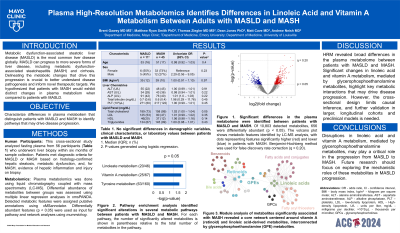Tuesday Poster Session
Category: Liver
P4612 - Plasma High-Resolution Metabolomics Identifies Differences in Linoleic Acid and Vitamin A Metabolism Between Adults with Steatosis and Steatohepatitis
Tuesday, October 29, 2024
10:30 AM - 4:00 PM ET
Location: Exhibit Hall E

Has Audio
.jpg)
Brent J. Gawey, MD, MSc
Mayo Clinic
Rochester, MN
Presenting Author(s)
Award: Presidential Poster Award
Brent J. Gawey, MD, MSc1, Matthew R. Smith, PhD2, Yagmur Y. Comba, MD1, Thomas R. Ziegler, MD, MSc2, Dean P. Jones, PhD2, Andrew S. Neish, MD2, Mattew Cave, MD3
1Mayo Clinic, Rochester, MN; 2Emory University School of Medicine, Atlanta, GA; 3University of Louisville School of Medicine, Louisville, KY
Introduction: Metabolic dysfunction-associated steatotic liver disease (MASLD) is the most common chronic liver disease globally. MASLD can progress to metabolic dysfunction-associated steatohepatitis (MASH), which can ultimately lead to hepatic cirrhosis. Delineating the metabolic changes that drive this progression is crucial for better understanding the disease pathogenesis and informing therapeutic interventions. High-resolution metabolomics (HRM) is a platform that allows for the profiling of metabolic features in biological samples. In this study, HRM was used to assess changes in metabolic pathways between patients with steatosis and steatohepatitis.
Methods: This cross-sectional study included 56 participants. Fasting plasma was analyzed using liquid chromatography coupled with mass spectrometry for HRM. Participants had undergone liver biopsy within 6 months of plasma sample collection. A histopathological diagnosis was provided by a central expert pathologist. The differential abundance of metabolites between steatosis and steatohepatitis groups was assessed using multiple linear regression analyses. The top-ranked metabolites (p < 0.05) were further analyzed using the mummichog informatics package to identify differing metabolic pathways and networks between the groups.
Results: Of 10,803 detected metabolites, 656 were differentially abundant (p < 0.05) between steatosis and steatohepatitis groups. These metabolites were selected for pathway analysis, which revealed significant differences (p < 0.05) in linoleic acid and vitamin A metabolism. Module analysis revealed a network formed by vitamin A and linoleic acid-derived metabolites connected by glycerophosphoethanolamine metabolites, which was significantly associated with the steatohepatitis group.
Discussion: Plasma HRM data revealed changes in metabolic pathways between patients with steatosis and steatohepatitis. The differential abundance of metabolites involved in linoleic acid and vitamin A metabolism suggests these pathways play an important role in the pathogenesis of steatohepatitis. The identified network of vitamin A and linoleic acid-derived metabolites, mediated by a subclass of bioactive lipids, highlights metabolic interactions that may drive disease progression. These results provide insight into the metabolic underpinnings of MASLD progression and may inform therapeutic strategies targeting these pathways. Further research is needed to validate these findings and explore their potential clinical applications.
Disclosures:
Brent J. Gawey, MD, MSc1, Matthew R. Smith, PhD2, Yagmur Y. Comba, MD1, Thomas R. Ziegler, MD, MSc2, Dean P. Jones, PhD2, Andrew S. Neish, MD2, Mattew Cave, MD3. P4612 - Plasma High-Resolution Metabolomics Identifies Differences in Linoleic Acid and Vitamin A Metabolism Between Adults with Steatosis and Steatohepatitis, ACG 2024 Annual Scientific Meeting Abstracts. Philadelphia, PA: American College of Gastroenterology.
Brent J. Gawey, MD, MSc1, Matthew R. Smith, PhD2, Yagmur Y. Comba, MD1, Thomas R. Ziegler, MD, MSc2, Dean P. Jones, PhD2, Andrew S. Neish, MD2, Mattew Cave, MD3
1Mayo Clinic, Rochester, MN; 2Emory University School of Medicine, Atlanta, GA; 3University of Louisville School of Medicine, Louisville, KY
Introduction: Metabolic dysfunction-associated steatotic liver disease (MASLD) is the most common chronic liver disease globally. MASLD can progress to metabolic dysfunction-associated steatohepatitis (MASH), which can ultimately lead to hepatic cirrhosis. Delineating the metabolic changes that drive this progression is crucial for better understanding the disease pathogenesis and informing therapeutic interventions. High-resolution metabolomics (HRM) is a platform that allows for the profiling of metabolic features in biological samples. In this study, HRM was used to assess changes in metabolic pathways between patients with steatosis and steatohepatitis.
Methods: This cross-sectional study included 56 participants. Fasting plasma was analyzed using liquid chromatography coupled with mass spectrometry for HRM. Participants had undergone liver biopsy within 6 months of plasma sample collection. A histopathological diagnosis was provided by a central expert pathologist. The differential abundance of metabolites between steatosis and steatohepatitis groups was assessed using multiple linear regression analyses. The top-ranked metabolites (p < 0.05) were further analyzed using the mummichog informatics package to identify differing metabolic pathways and networks between the groups.
Results: Of 10,803 detected metabolites, 656 were differentially abundant (p < 0.05) between steatosis and steatohepatitis groups. These metabolites were selected for pathway analysis, which revealed significant differences (p < 0.05) in linoleic acid and vitamin A metabolism. Module analysis revealed a network formed by vitamin A and linoleic acid-derived metabolites connected by glycerophosphoethanolamine metabolites, which was significantly associated with the steatohepatitis group.
Discussion: Plasma HRM data revealed changes in metabolic pathways between patients with steatosis and steatohepatitis. The differential abundance of metabolites involved in linoleic acid and vitamin A metabolism suggests these pathways play an important role in the pathogenesis of steatohepatitis. The identified network of vitamin A and linoleic acid-derived metabolites, mediated by a subclass of bioactive lipids, highlights metabolic interactions that may drive disease progression. These results provide insight into the metabolic underpinnings of MASLD progression and may inform therapeutic strategies targeting these pathways. Further research is needed to validate these findings and explore their potential clinical applications.
Disclosures:
Brent Gawey indicated no relevant financial relationships.
Matthew Smith indicated no relevant financial relationships.
Yagmur Comba indicated no relevant financial relationships.
Thomas Ziegler indicated no relevant financial relationships.
Dean Jones indicated no relevant financial relationships.
Andrew Neish indicated no relevant financial relationships.
Mattew Cave indicated no relevant financial relationships.
Brent J. Gawey, MD, MSc1, Matthew R. Smith, PhD2, Yagmur Y. Comba, MD1, Thomas R. Ziegler, MD, MSc2, Dean P. Jones, PhD2, Andrew S. Neish, MD2, Mattew Cave, MD3. P4612 - Plasma High-Resolution Metabolomics Identifies Differences in Linoleic Acid and Vitamin A Metabolism Between Adults with Steatosis and Steatohepatitis, ACG 2024 Annual Scientific Meeting Abstracts. Philadelphia, PA: American College of Gastroenterology.

